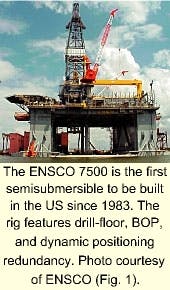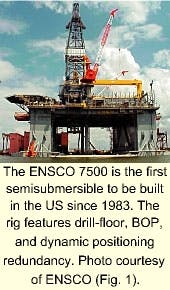The first-ever, US-built, deepwater semisubmersible, ENSCO International Inc.'s ENSCO 7500, is scheduled to spud its first well this month in East Breaks Block 599, Gulf of Mexico (GOM) under a 3-year contract with Burlington Resources Inc. Once this term expires, Burlington has three additional 1-year options.
In addition to this rig, ENSCO has 22 jackups operating in the GOM, 8 in the North Sea, 2 in the Middle East, 1 in Australia, and 4 in Southeast Asia. The company has 9 barges in Lake Maracaibo and 7 GOM platforms. One of its drilling platform rigs currently works for ExxonMobil Corp. in the Diana-Hoover field in 4,800 ft of water.
The vessel, built in less than 2 years at Friede Goldman's yards at Orange and Port Arthur, Tex., is rated to 7,500 ft of water and a drilling depth of 30,000 ft.
According to John Knowlton, project manager for ENSCO, construction costs were one-half to two-thirds of the latest generation of semisubmersibles. "We had a huge advantage because of the relatively simple construction," he said. "For example, we used flat plates with few rounded corners and we minimized the tubular members."
Redundancy
The ENSCO 7500 is a dynamic positioned DP-2 class vessel with two levels of station-keeping redundancy. For example, if the global positioning satellite network goes down, the rig can turn to acoustic sensors mounted on the seabed and ship hull.
The drill floor, which is fully automated, consists of a pipe-racking system, iron roughneck, top drive, mousehole spider, and hydraulic slips (Fig. 2).
Thus, crewmembers can build bottomhole assemblies, drill stands, and landing strings offline without stopping the drilling process. Redundancy also is built into the rig as all drill-floor operations can be performed manually.
Furthermore, the rig has a spare 15,000-psi blowout preventer and 5,000 ft of additional riser.
Deck load, solids control
While drilling, the ENSCO 7500 can handle a deck load of 8,500 tons. During transit, the semisubmersible can carry 4,900 tons. The setback area can hold 425 stands of 51/2-in. drill pipe, 90 stands of landing string, and 10 stand of drill collars.
A unique feature of the rig is the way in which the large pipe storage area (100 ft long) can be fully accessed with either deck or gantry cranes. Thus, workers can convey riser or drill pipe in one motion up to the drill floor.
The solids-control equipment consists of five Brandt (a Varco Co.) cascading shale shakers in addition to a series of desanders and desilters. Decanting centrifuges can be added at the request of the operator.
The active mud system holds 3,639 bbl, while the reserve mud system holds 8,564 bbl.



